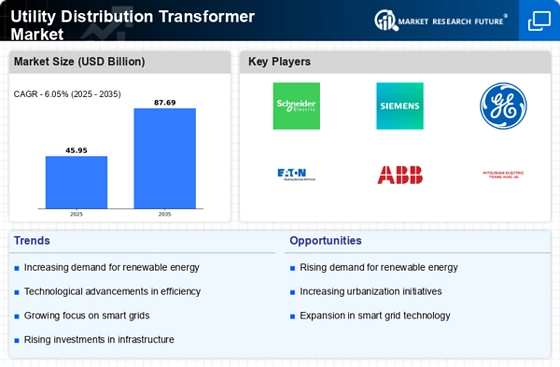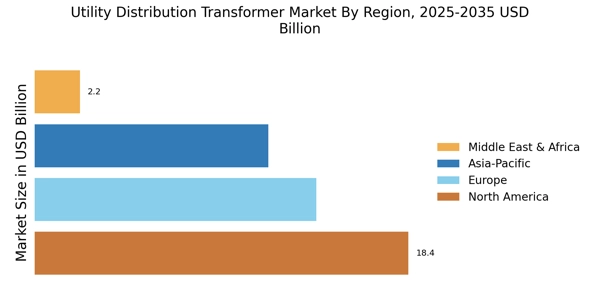Integration of Renewable Energy Sources
The integration of renewable energy sources into the power grid is a pivotal factor for the Utility Distribution Transformer Market. As countries strive to meet sustainability goals, the demand for transformers that can accommodate variable energy sources such as solar and wind is rising. This shift necessitates the development of advanced distribution transformers capable of handling fluctuations in power supply. Market analysis indicates that the share of renewable energy in the global energy mix is expected to reach 50% by 2030. This transition not only enhances grid resilience but also drives the need for innovative transformer solutions. Therefore, the Utility Distribution Transformer Market is likely to expand as utilities adapt to the changing energy landscape.
Regulatory Support for Energy Efficiency
Regulatory frameworks promoting energy efficiency are significantly influencing the Utility Distribution Transformer Market. Governments worldwide are implementing stringent regulations aimed at reducing energy consumption and greenhouse gas emissions. These regulations often mandate the use of energy-efficient transformers, which are designed to minimize losses during electricity distribution. For example, the implementation of standards such as the IEEE C57.12.00 has led to a shift towards more efficient transformer technologies. This regulatory support not only encourages manufacturers to innovate but also drives utility companies to upgrade their existing infrastructure. Consequently, the Utility Distribution Transformer Market is poised for growth as compliance with these regulations becomes increasingly essential.
Rising Investment in Smart Grid Technologies
Investment in smart grid technologies is emerging as a significant driver for the Utility Distribution Transformer Market. Smart grids enhance the efficiency and reliability of electricity distribution through advanced monitoring and control systems. These technologies enable utilities to optimize transformer performance and reduce operational costs. As governments and private sectors allocate substantial funds towards smart grid initiatives, the demand for smart transformers is expected to rise. Reports suggest that the smart grid market could reach a valuation of over 100 billion by 2026, indicating a robust growth trajectory. This investment trend is likely to propel the Utility Distribution Transformer Market forward, as utilities seek to modernize their infrastructure and improve service delivery.
Technological Advancements in Transformer Design
The Utility Distribution Transformer Market is experiencing a notable transformation due to technological advancements in transformer design. Innovations such as improved materials and enhanced cooling techniques are leading to more efficient and reliable transformers. For instance, the introduction of amorphous steel in transformer cores has been shown to reduce energy losses significantly. As a result, the market is projected to grow at a compound annual growth rate of approximately 6% over the next few years. These advancements not only improve performance but also extend the lifespan of transformers, thereby reducing maintenance costs for utility companies. Consequently, the integration of these technologies is likely to drive demand within the Utility Distribution Transformer Market.
Increasing Urbanization and Infrastructure Development
Urbanization is a critical driver for the Utility Distribution Transformer Market, as the rapid growth of urban areas necessitates the expansion of electrical infrastructure. With more people moving to cities, the demand for reliable electricity supply is surging. This trend is particularly evident in developing regions, where urban centers are expanding at an unprecedented rate. According to recent estimates, urban areas are expected to house nearly 70% of the global population by 2050. This demographic shift compels utility providers to invest in distribution transformers to ensure adequate power supply. As a result, the Utility Distribution Transformer Market is likely to witness increased investments in infrastructure development to meet the rising energy demands of urban populations.


















Leave a Comment